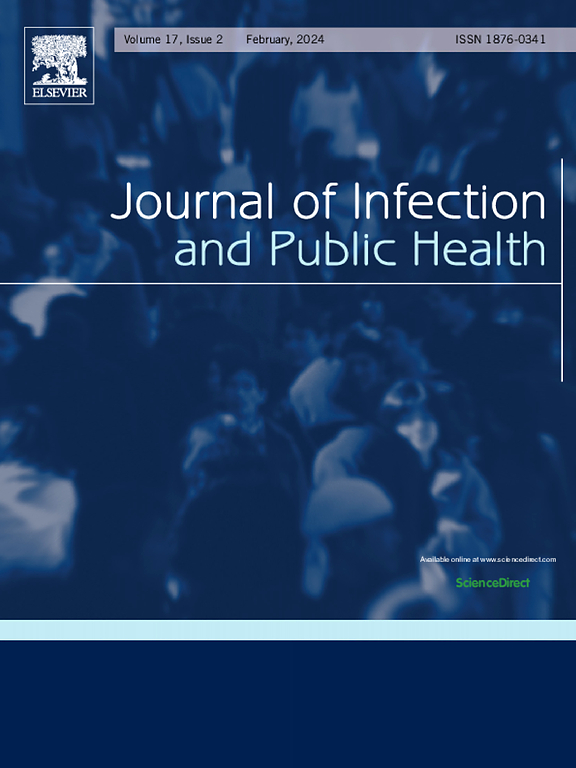The burden of viral skin diseases in the Middle East and North Africa region, 1990–2021
IF 4.7
3区 医学
Q1 INFECTIOUS DISEASES
引用次数: 0
Abstract
Objective
To report the prevalence, incidence, and Years Lived with Disability (YLD) due to viral skin diseases (VSD) in the MENA region from 1990 to 2021, focusing on age, sex, and socio-demographic index (SDI) using GBD 2021 data.
Methods
Data on the burden of VSD were sourced from the Global Burden of Disease (GBD) 2021 study, covering 21 countries in the MENA region. The results included the counts and age-standardised rates per 100,000 population, along with the associated 95 % uncertainty intervals (UIs).
Results
In 2021, the MENA region exhibited an age-standardised prevalence rate of 1257.6 cases per 100,000 population for VSD and an incidence rate of 990.5 cases per 100,000. Prevalence rates peaked sharply in the 5–9 age group before declining with age for both sexes, indicating a higher burden in younger populations. A strong positive relationship existed between the YLD rate and SDI, suggesting an increased burden of VSD with higher SDIs.
Conclusion
This study highlights the increasing burden of viral skin diseases (VSD) in the MENA region, especially among younger populations, with males also experiencing a slightly higher burden than females. Given the influence of multiple factors, a comprehensive strategy focusing on data systems, healthcare delivery, and regional collaboration is vital. Addressing these areas will help mitigate VSD's impact and improve health outcomes.
1990-2021年中东和北非区域病毒性皮肤病负担
目的报告1990年至2021年中东和北非地区病毒性皮肤病(VSD)的患病率、发病率和残疾生活年数(YLD),重点关注年龄、性别和使用GBD 2021数据的社会人口指数(SDI)。方法VSD负担数据来源于全球疾病负担(GBD) 2021研究,涵盖中东和北非地区的21个国家。结果包括每10万人的计数和年龄标准化率,以及相关的95% %不确定区间(UIs)。结果2021年,中东和北非地区VSD年龄标准化患病率为1257.6例/ 10万人,发病率为990.5例/ 10万人。患病率在5-9岁年龄组急剧达到峰值,然后随着年龄的增长而下降,这表明年轻人群的负担更高。YLD率与SDI呈正相关,表明SDI越高,VSD负担越重。结论本研究强调了中东和北非地区病毒性皮肤病(VSD)负担的增加,特别是在年轻人群中,男性的负担也略高于女性。考虑到多种因素的影响,以数据系统、医疗保健服务和区域协作为重点的综合战略至关重要。解决这些问题将有助于减轻VSD的影响并改善健康结果。
本文章由计算机程序翻译,如有差异,请以英文原文为准。
求助全文
约1分钟内获得全文
求助全文
来源期刊

Journal of Infection and Public Health
PUBLIC, ENVIRONMENTAL & OCCUPATIONAL HEALTH -INFECTIOUS DISEASES
CiteScore
13.10
自引率
1.50%
发文量
203
审稿时长
96 days
期刊介绍:
The Journal of Infection and Public Health, first official journal of the Saudi Arabian Ministry of National Guard Health Affairs, King Saud Bin Abdulaziz University for Health Sciences and the Saudi Association for Public Health, aims to be the foremost scientific, peer-reviewed journal encompassing infection prevention and control, microbiology, infectious diseases, public health and the application of healthcare epidemiology to the evaluation of health outcomes. The point of view of the journal is that infection and public health are closely intertwined and that advances in one area will have positive consequences on the other.
The journal will be useful to all health professionals who are partners in the management of patients with communicable diseases, keeping them up to date. The journal is proud to have an international and diverse editorial board that will assist and facilitate the publication of articles that reflect a global view on infection control and public health, as well as emphasizing our focus on supporting the needs of public health practitioners.
It is our aim to improve healthcare by reducing risk of infection and related adverse outcomes by critical review, selection, and dissemination of new and relevant information in the field of infection control, public health and infectious diseases in all healthcare settings and the community.
 求助内容:
求助内容: 应助结果提醒方式:
应助结果提醒方式:


